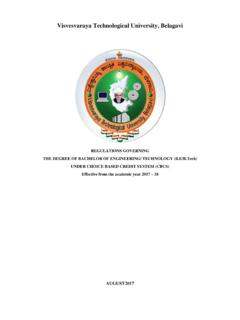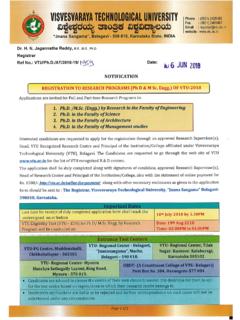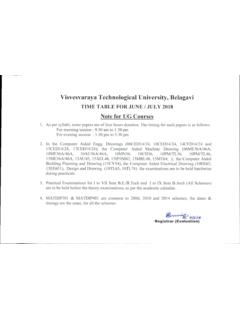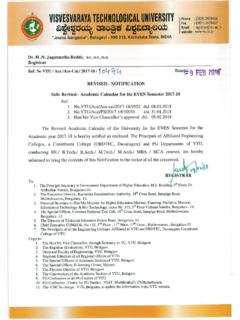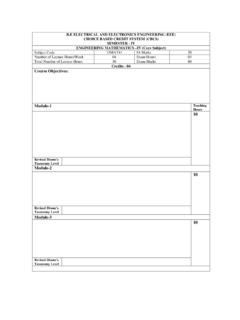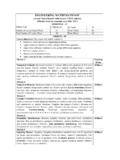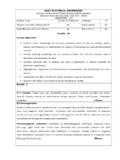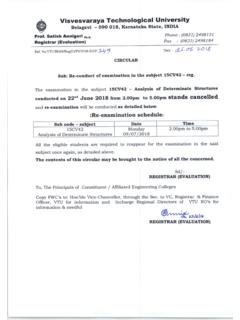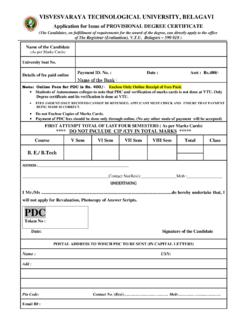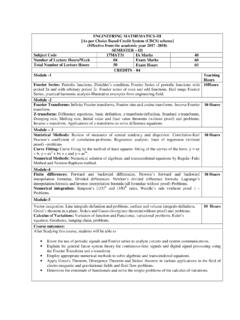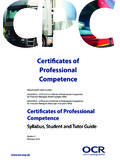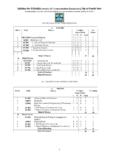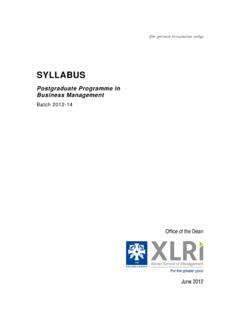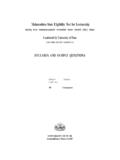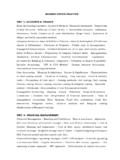Transcription of MICROPROCESSORS SEMESTER IV (EC/TC
1 MICROPROCESSORS . [As per Choice Based Credit System (CBCS) scheme]. SEMESTER IV (EC/TC. Subject Code 15EC42 IA Marks 20. Number of Lecture 04 Exam Marks 80. Hours/Week Total Number of 50 Exam Hours 03. LectureHours CREDITS 04. Course objectives: This course will enable students to: Familiarize basic architecture of 8086 microprocessor Program 8086 microprocessor using Assembly Level Language Use Macros and Procedures in 8086 Programs Understand interfacing of 16 bit microprocessor with memory and peripheral chips involving system design Understand the architecture of 8088, 8087 Coprocessor and other CPU. architectures Revised Teach Bloom's Modules ing Taxonomy Hours (RBT) Level Module -1. 8086 PROCESSOR: Historical background (refer Reference Book 1), 8086 CPU Architecture ( of Text). Addressing modes, Machine language instruction formats, 10 L1, L2, L3.)
2 Machine coding the program ( , , of Text). Hours INSTRUCTION SET OF 8086: Data transfer and arithmetic instructions. Control/Branch Instructions, Illustration of these instructions with example programs ( of Text). Module -2. Logical Instructions, String manipulation instructions, Flag 10 L1, L2, L3. manipulation and Processor control instructions, Illustration Hours of these instructions with example programs. Assembler Directives and Operators, Assembly Language Programming and example programs ( , , of Text). Module -3. Stack and Interrupts: 10 L1, L2, L3. Introduction to stack, Stack structure of 8086, Programming Hours for Stack. Interrupts and Interrupt Service routines, Interrupt cycle of 8086, NMI, INTR, Interrupt programming, Passing parameters to procedures, Macros, Timing and Delays. (Chap.)
3 4 of Text). Module -4. 8086 Bus Configuration and Timings: 10 L1, L2, L3. Physical memory Organization, General Bus operation cycle, Hours I/O addressing capability, Special processor activities, Minimum mode 8086 system and Timing diagrams, Maximum Mode 8086 system and Timing diagrams. ( to of Text). Basic Peripherals and their Interfacing with 8086 (Part 1): Static RAM Interfacing with 8086 ( ), Interfacing I/O. ports, PIO 8255, Modes of operation Mode-0 and BSR Mode, Interfacing Keyboard and 7-Segment digits using 8255 (Refer , , of Text). Module 5. Module 5 10 L1, L2, L3. Basic Peripherals and their Interfacing with 8086 (Part 2): Hours Interfacing ADC-0808/0809, DAC-0800, Stepper Motor using 8255. ( , , ). Timer 8254 Mode 0, 1, 2 & 3 and Interfacing programmes for these modes (refer of Text).
4 INT 21H DOS Function calls - for handling Keyboard and Display (refer Appendix-B of Text). Other Architectures: Architecture of 8088 (refer upto of Text) and Architecture of NDP 8087 (refer , of Text). Von-Neumann & Harvard CPU architecture and CISC & RISC. CPU architecture (refer Reference Book 1). Course outcomes: At the end of the course students will be able to: Explain the History of evaluation of MICROPROCESSORS , Architecture of 8086, 8088, 8087, CISC & RISC, Von-Neumann & Harvard CPU architecture Write 8086 Assembly level programs using the 8086 instruction set Write modular programs using procedures and macros. Write 8086 Stack and Interrupts programming Interface 8086 to Static memory chips and 8255, 8254, 0808 ADC, 0800 DAC, Keyboard, Display and Stepper motors. Use INT 21 DOS interrupt function calls to handle Keyboard and Display Graduating Attributes (as per NBA).
5 Engineering Knowledge Problem Analysis Design / development of solutions (partly). Question paper pattern: The question paper will have ten questions. Each full Question consisting of 16marks There will be 2 full questions (with a maximum of four sub questions) from each module. Each full question will have sub questions covering all the topics under a module. The students will have to answer 5 full questions, selecting one full question from each module. Text Book: Advanced MICROPROCESSORS and Peripherals - Ray and Bhurchandi, TMH, 3rd Edition, 2012, ISBN 978-1-25-900613-5. Reference Books: 1. microprocessor and Interfacing - Douglas V Hall, SSSP Rao, 3rd edition TMH, 2012. 2. Microcomputer systems-The 8086 / 8088 Family Liu and A. Gibson, 2nd edition, PHI -2003. 3. The 8086 microprocessor : Programming & Interfacing the PC.
6 Kenneth J Ayala, CENGAGE Learning, 2011. 4. The Intel microprocessor , Architecture, Programming and Interfacing - Barry B. Brey, 6e, Pearson Education / PHI, 2003. CONTROL SYSTEMS. [As per Choice Based Credit System (CBCS) scheme]. SEMESTER IV (EC/TC). Subject Code 15EC43 IA Marks 20. Number of Lecture 04 Exam Marks 80. Hours/Week Total Number of 50 Exam Hours 03. Lecture Hours CREDITS 04. Course objectives: This course will enable students to: Know the basic features, configurations and application of control systems. Know various terminologies and definitions for the control systems. Learn how to find a mathematical model of electrical, mechanical and electro- mechanical systems. Know how to find time response from the transfer function. Find the transfer function via Masons rule. Analyze the stability of a system from the transfer function.
7 Revised Teaching Bloom's Modules Hours Taxonomy (RBT) Level Module -1. Introduction to Control Systems: Types of Control Systems, Effect of Feedback Systems, Differential equation of 10 Hours L1, L2, L3. Physical Systems Mechanical Systems, Electrical Systems, Analogous Systems. Block diagrams and signal flow graphs: Transfer functions, Block diagram algebra and Signal Flow graphs. Module -2. Time Response of feedback control systems: Standard test 10 Hours L1, L2, L3. signals, Unit step response of First and Second order Systems. Time response specifications, Time response specifications of second order systems, steady state errors and error constants. Introduction to PI, PD and PID. Controllers (excluding design). Module -3. Stability analysis: Concepts of stability, Necessary 10 Hours L1, L2, L3.
8 Conditions for Stability, Routh stability criterion, Relative stability analysis: more on the Routh stability criterion, Introduction to Root-Locus Techniques, The root locus concepts, Construction of root loci. Module -4. Frequency domain analysis and stability: 10 Hours L1, L2, L3. Correlation between time and frequency response, Bode Plots, Experimental determination of transfer function. Introduction to Polar Plots, (Inverse Polar Plots excluded). Mathematical preliminaries, Nyquist Stability criterion, (Systems with transportation lag excluded). Introduction to lead, lag and lead-lag compensating networks (excluding design). Module -5. Introduction to Digital Control System: Introduction, 10 Hours L1, L2, L3. Spectrum Analysis of Sampling process, Signal reconstruction, Difference equations. Introduction to State variable analysis: Introduction, Concept of State, State variables & State model, State model for Linear Continuous & Discrete time systems, Diaganolisation.
9 Course outcomes: At the end of the course, the students will be able to Develop the mathematical model of mechanical and electrical systems Understand time domain specifications for first and second order systems Determine the stability of a system in the time domain using Route Harvitz criteria and root locus technique Determine the stability of a system in the frequency domain using Nyquist and bode plots Model a control system in continuous and discrete time using state variable techniques Graduating Attributes (as per NBA). Engineering Knowledge Problem Analysis Design / development of solutions (partly). Question paper pattern: The question paper will have ten questions. Each full Question consisting of 16 marks There will be 2 full questions (with a maximum of four sub questions) from each module.
10 Each full question will have sub questions covering all the topics under a module. The students will have to answer 5 full questions, selecting one full question from each module. Text Book: and , Control Systems Engineering , New Age International (P). Limited, Publishers, Fifth edition-2005, ISBN: 81-224-2008-7. Reference Books: 1. Modern Control Engineering, , Pearson Education Asia/PHI, 4 th Edition, 2002. ISBN 978-81-203-4010-7. 2. Automatic Control Systems , Benjamin C. Kuo, John Wiley India Pvt. Ltd., 8th Edition, 2008. 3. Feedback and Control System, Joseph J Distefano III et al., Schaum s Outlines, TMH, 2nd Edition 2007. 1. SIGNALS AND SYSTEMS. [As per Choice Based Credit System (CBCS) scheme]. SEMESTER IV (EC/TC). Subject Code 15EC44 IA Marks 20. Number of Lecture 04 Exam Marks 80. Hours/Week Total Number of 50 Exam Hours 03.
